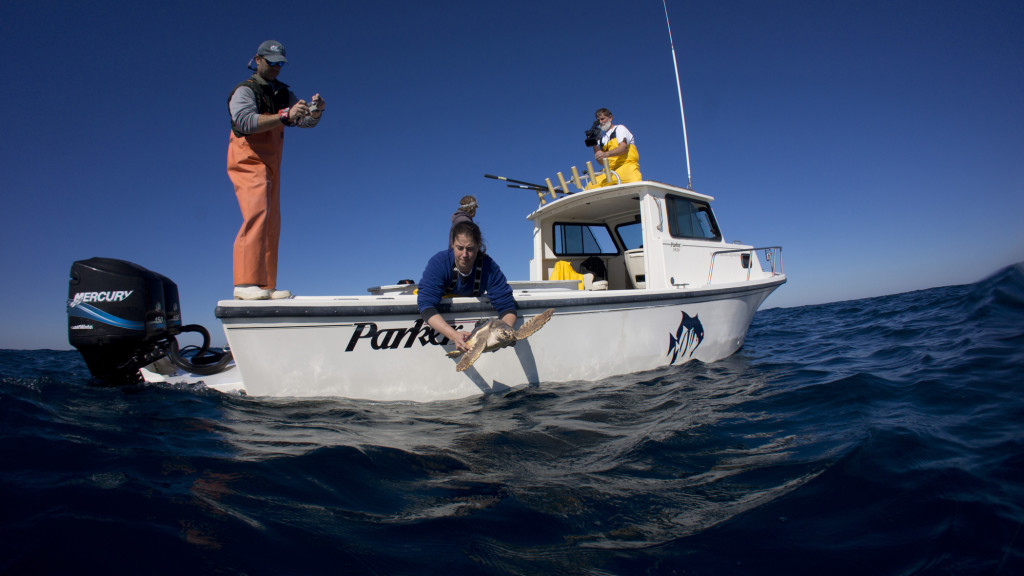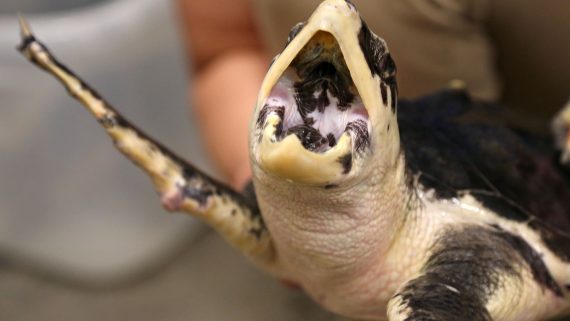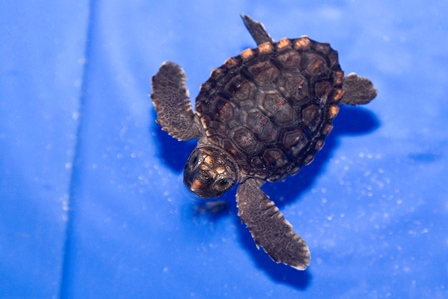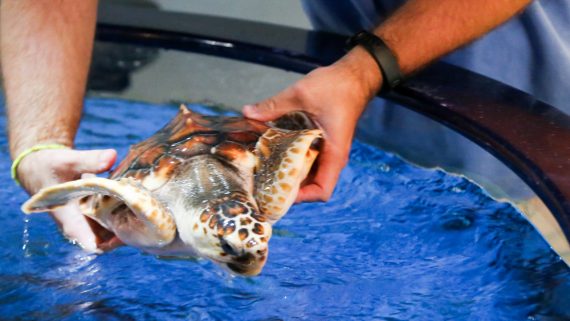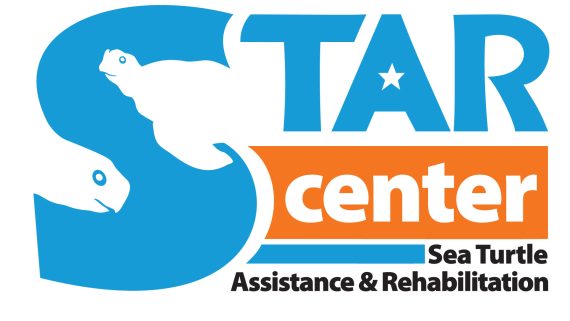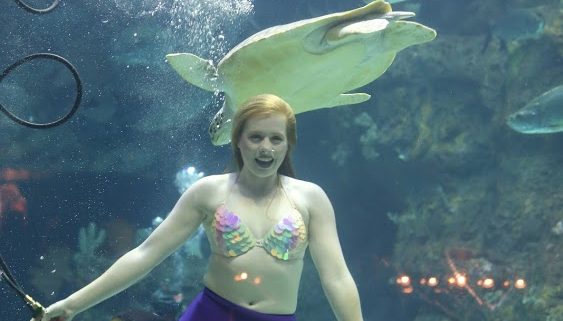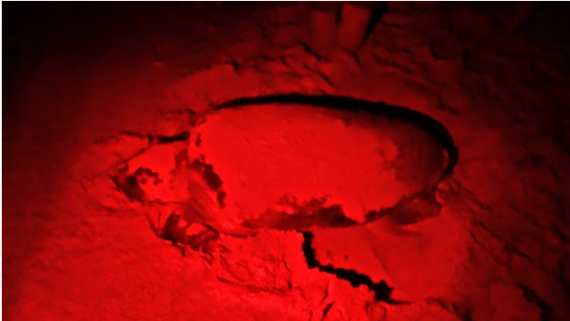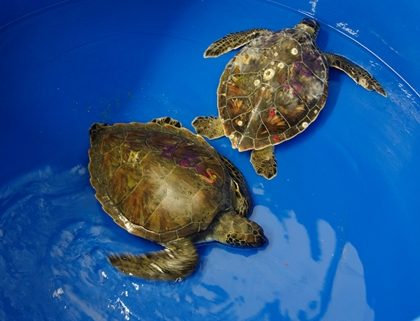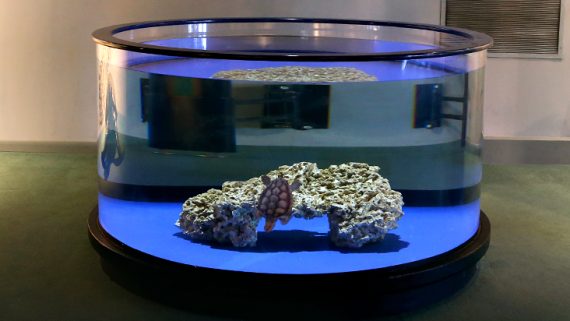The boat rocked gently, adrift in the Gulf Stream. A small crew from the North Carolina Aquarium at Fort Fisher watched as their co-worker lifted a juvenile loggerhead sea turtle from a holding area and held firmly, careful to avoid the tracking device attached to the shell. A smile on her face, Aquarist Julie Johnson turned to lower the animal over the boat railing. The sea turtle’s flippers pushed air then water with powerful, determined strokes. Johnson released her charge and in seconds the loggerhead propelled itself away from the boat and into the depths of the warm, blue water.
In years past, this is where the story would end. Aquarium staff releases yearling loggerheads each fall off the North Carolina coast. Yet, no one knew what happened to the young sea turtles after they swam from sight. Loggerheads are a mystery, in general, as they spend most of their lives in the open ocean.
“Once loggerheads leave as hatchlings we don’t see them again until they are adults and return to our coastline for nesting,” said Aquarium Curator Hap Fatzinger. “We know very little about these first 15 or 20 years in a loggerhead’s life. Where do our North Carolina loggerheads go? We don’t know.”
Some valuable information has been gathered from older, larger loggerheads equipped with satellite tracking devices. Yet many gaps in movement and behavioral data remain. The large size of the tracking devices prevented their use with smaller animals like the yearling loggerheads released by the Aquarium.
Now, however, the Aquarium hopes to fill in some of the unknowns. For the first time the Aquarium will track and gather data on newly released sea turtles thanks to evolving technology and a new pilot research program.
Watch Tagging and Release Video Here.
Each summer, the Aquarium works with N.C. Wildlife Resources Commission and local sea turtle rescue organizations, accepting a limited number of hatchlings that did not make the initial trek to the ocean. Generally, these turtles are discovered during routine nest excavations three days after hatching.
In August 2011, the Aquarium acquired three hatchling loggerheads from the Pleasure Island Sea Turtle Project, excavated from two separate nests in Kure Beach and Carolina Beach. During the turtles’ stay at the Aquarium, the animals received careful monitoring and care to ensure proper growth and good health. In addition, they helped educate more than 400,000 visitors about sea turtle species, all of which are threatened or endangered.
In November, Aquarium staff prepared the 15-month old loggerheads for release. They were examined by a team of veterinarians from North Carolina State University and affixed with battery-powered satellite transmitters.
The down-sized devices weighed less than 2 ounces and measured only 3 inches. A pad of flexible neoprene to allow for shell growth and epoxy were used to secure the transmitters to the turtles’ shells, or carapaces; and a specially-formulated coating was applied to inhibit barnacles. The devices were programmed to transmit the turtles’ locations each time they surface. Staff observed the turtles for an extended period after the application process to ensure the attached transmitters had no effect on the turtles’ ability to maneuver, swim or eat.
On November 26, Aquarium staff piloted the loggerheads, named Kure, Carolina and Aqua, approximately 60 miles off the coast for their successful release into 72 degree Gulf Stream waters. Once back on land, staff detected signals from Kure and Carolina and began tracking their movements by computer. Aqua’s signal could not be detected.
“No signal doesn’t necessarily mean anything bad happened to the turtle,” said Johnson, the turtles’ primary caretaker during their Aquarium residency. “There are a number of variables including faulty sensors, weak battery and tag damage that could be the cause.”
Ideally, transmissions from Kure and Carolina will continue for a year. Uncontrollable variables, however, including damage to the transmitter and battery life may shorten the time frame. Eventually, the animals’ shells will outgrow the stretchy neoprene and the devices will fall off.
Yet no matter the timeline, Aquarium staff are optimistic.
“Any data we gather is valuable,” said Fatzinger. “This program is a starting point. It’s an opportunity to learn more and apply it in the future.”
In addition to the data and research gathered by the Aquarium, the public can also follow the animals’ progress and learn more about sea turtles at seaturtle.org.
Watch tagging and release video here.
BY THE NUMBERS
Average hatch weight of Aqua, Carolina and Kure: .51 ounces
Average hatch length of Aqua, Carolina and Kure: 1.8 inches
Average weight of Aqua, Carolina and Kure release: 13.7 pounds
Average curved shell length of Aqua, Carolina and Kure at release: 15 inches
Miles traveled by Carolina in first 10 days: 781
Miles traveled by Kure in first 10 days: 489


